In a massively competitive business landscape, successfully marketing small businesses can be a tough challenge. But one that we’re sure you’ll be ready to take on with the help of our ultimate guide on how to best market your small business.
Plan a strategy
If you fail to plan then you plan to fail, so the saying goes. Not only must you have a sound business plan, but you must also work up a sound marketing plan too.
Set some goals
The first thing you’ll need to do is to figure out what you’re hoping to get from your marketing strategy. Try to aim for quantitative goals, rather than qualitative ones (like number of website visitors, number of clicks, amount of revenue generated) because these are easier to measure. Really hone in on what you want your marketing efforts to do for you; are you more focused on lead generation, website traffic, social media engagement or sales conversions?
And while it’s best to prioritise the quantitative factors, don’t forget to keep things like brand perception, visibility and loyalty simmering away in your efforts too.

Identify your audience
In order for you to set a strategy, you must first work out who you’re trying to speak to. If your message doesn’t resonate with the people you want it to then your marketing plan will have little value.
The easiest way to do this is to survey your existing customer base; what are their demographics like, what do they all have in common and why have they chosen to become your customer? You can also compare the target audience of those businesses that you consider your competitors.
Online marketing
Once you’ve worked out what you want to say and who you want to say it to, it’s time to work out how you’re going to say it. With an increasingly digital-driven world, online marketing tactics are the natural choice, but there are plenty of different platforms within that category. The best way to go about your online marketing strategy is to consider the following;
Create great content
There is an element of ‘build it and they will come’ to this kind of marketing. Content marketing has the ability to go viral, boosting your brand visibility very quickly. So in order to be in with that chance, you must focus first on creating high quality images, articles, blog posts, videos and podcasts. Make sure that you have excellent, creative content across all your platforms including your website, social media posts and blog (if applicable).

Consider SEO
As well as putting together amazing content though, you need to make it as easy as possible for people to find you in a crowded market. So remember to optimise all your content for SEO, including keywords and backlinks to help users easily navigate around your site and hopefully stay on there for as long as possible.
Social media
Social media is a very powerful tool and is the platform that a lot of people use to discover new shops, businesses and brands. For your best chance at brand awareness, create profiles on all major social media platforms and ensure you update them regularly. It’s important that you maintain a personable presence on social media, as users will want to get to know you as a brand, rather than as a sales pitch. Consider things like behind the scenes footage, sneak peaks or new products and personal stories from you or your staff members.

Once you have a contact database built up, email marketing is a great way to speak directly to your customers and to know more definitively that your content is being seen. Make sure to strike the right balance on frequency though; too many and you’ll seem like you’re spamming but too few and your customers will lose touch with you. What you send is entirely reliant on your sector and business but remember to create interlinking between your emails, website and social media channels.
Advertising
Online advertising now comes in many different forms and all of them are worth incorporating in to your marketing plan. Instagram and Facebook ads both have good success rates, while placing a banner advert in an industry magazine can prove fruitful (depending on what your business does). Whatever medium you go for, ensure that adverts are high quality and eye-catching. It’s also worth doing a trial-run advert with a smaller budget than intended, to see if it’s really worth investing a lot of money in.

Measure results
No matter what form your online marketing takes, you must always measure your results. There are a number of analytics platforms you can use. Most social media platforms have these directly built in, while Google Analytics is a good choice for tracking the success of your website. Have a look at what was most visited, what was most clicked on and how people moved around your site, and then see if there are any good tactics you can take forward.
Offline marketing
Of course, not everything about getting your small business seen needs to be in the digital world. There are a number of ways away from the screen that you can help your business to grow.
Networking
Networking is absolutely essential and something that you should never stop doing, even if and when your business is a household name. Making key connections and building those relationships will help you to create a customer base, who you can then market to. And don’t underestimate the power of word-of-mouth.

Events
Again, there’s still something very popular about face-to-face interactions and there’s no better way to achieve these than with event marketing. Go along as an attendee to relevant industry events or, if you have a bigger budget to put behind it, hire space at an exhibition event in your sector. This not only helps you to get your brand out there, but also gives you an easy way to network as people will be coming to you.
There are a number of different ways in which you can consider the world of print in your marketing plan. Firstly, just like with online adverts, you could consider a printed one. Secondly, You can try and get articles placed in industry publications. If you focus on high quality content, rather than a sales angle, then a number of publications should take your article for free, making it a great way to get your business seen. And lastly, the world of print encompasses things like flyers, brochures and other marketing collateral. Although it might seem like it’s all about social media these days, that content can be highly disposable, so don’t doubt the value of having something that people can hold on to.

Do you have a small business that you want help getting off the ground? Enter our competition to be in with the chance of winning a free 12 month Snizl marketing package, worth over £1,200!
